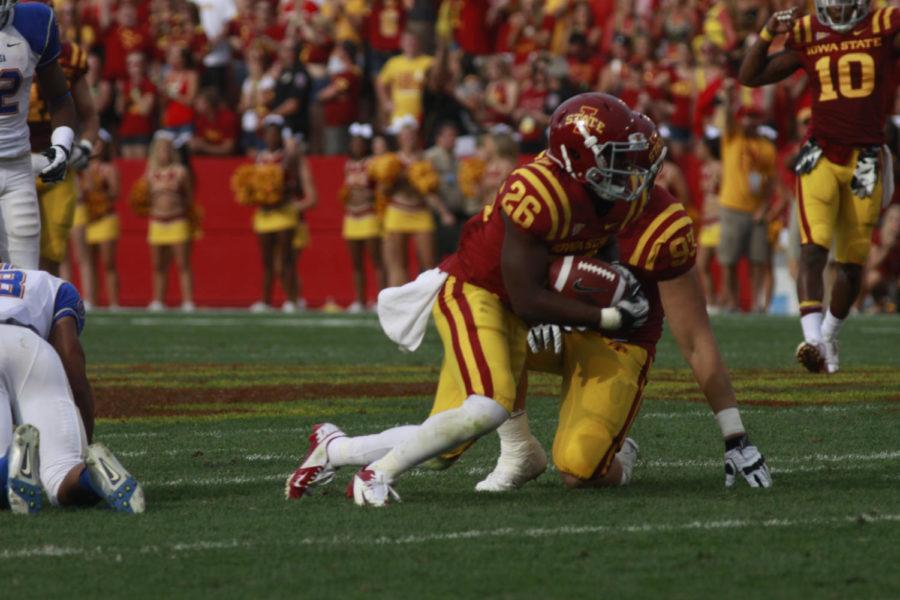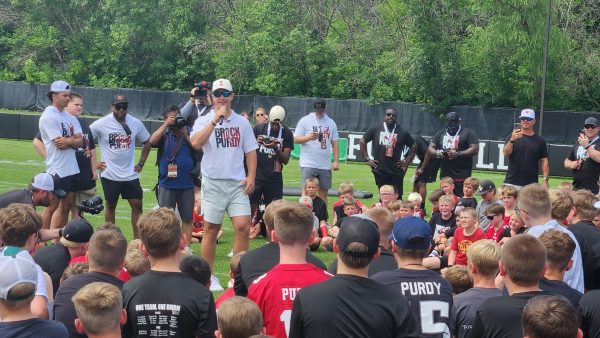COMMENTARY: George, Broomfield perfect for defensive systems
Defensive back Deon Broomfield returns an interception during the Cyclones’ 38-23 win against Tulsa on Saturday, Sept. 1, at Jack Trice Stadium.
September 5, 2012
The ISU football team’s 38-23 win against Tulsa on Saturday showed something thought to be only a myth for the longest time: The defense was stopping the run.
Take away Trey Watts’ 77-yard run at the beginning of the fourth quarter, and the ISU defense held the Golden Hurricane to 83 yards rushing. Yes, 83 yards rushing.
Last season the defense held only two opponents — Texas Tech and Oklahoma State — to less than 100 yards rushing. Both of those teams, mind you, were pass-heavy teams in the first place, so those feats are not as noteworthy.
The ISU defense has been switching between two schemes — its base defense of Jeremiah George taking the place as the third linebacker opposite Jake Knott and A.J. Klein and its nickel defense with Deon Broomfield playing as a hybrid linebacker/defensive back (“hy-backer”) for passing situations.
With George’s athleticism and Broomfield’s hitting ability that makes his 196-pound frame akin to that of a 220-pound linebacker, the balance of run-stopping and pass-stopping schemes reduces the uncertainty that comes with inconsistency that has plagued the unit in the past.
“They’re two playmakers,” said linebacker Jake Knott of George and Broomfield. “Bottom line: Those guys make plays. They’re fast. They’re physical. When you’ve got two guys like that that are rotating in, you want to get your best guys on the field, and they’re two of the best.”
In five of the team’s 13 games last season, the defense allowed more rushing yards than passing, which is quite alarming considering the national average of passing yards per game is 50 yards more than that of rushing.
George’s presence at Mike linebacker — which moves Klein to Sam — for base defense is the perfect answer to this seemingly continuing problem.
Last Saturday, George tallied five of his six total tackles stopping the run, using his athleticism to hunt down the ball carrier to make stops.
“Any predicament where you think they’re going to run the ball, or even if it’s a short pass, Jeremiah’s going to be in there,” Broomfield said. “He’s going to be our biggest guy who’s going to get the job done when we need him to get the job done.”
Broomfield, on the other hand, fills the role as the Cyclones’ “hy-backer,” incorporating his hitting ability in the fashion of a linebacker, while maintaining the coverage skills of a defensive back.
I hesitate to refer to Broomfield as a nickelback — partly because it’s also the name of an awful Canadian band — because defensive coordinator Wally Burnham said the hy-backer has more of a linebacker feel to it, which Broomfield plays perfectly.
“Deon Broomfield: He can do some things that I can’t do, and he allows for us to play different coverages,” George said. “I have no problem with it. He knows his role, I know my role — I’m more of a run-stopper, and he has the ability to interrupt passes.”
While their roles are well-established, George’s athleticism in covering receivers and Broomfield’s ability to move up in the box make this system more dynamic than it was last year when Matt Tau’fo’ou filled the void as Mike linebacker in base.
“What we can do out of base, out of nickel defense, it’s pretty good,” George said. “We’re going to keep tweaking it, we’re going to keep adjusting and keep making plays out of it.”
—
Jake Calhoun is a senior in journalism from Urbandale, Iowa.

















